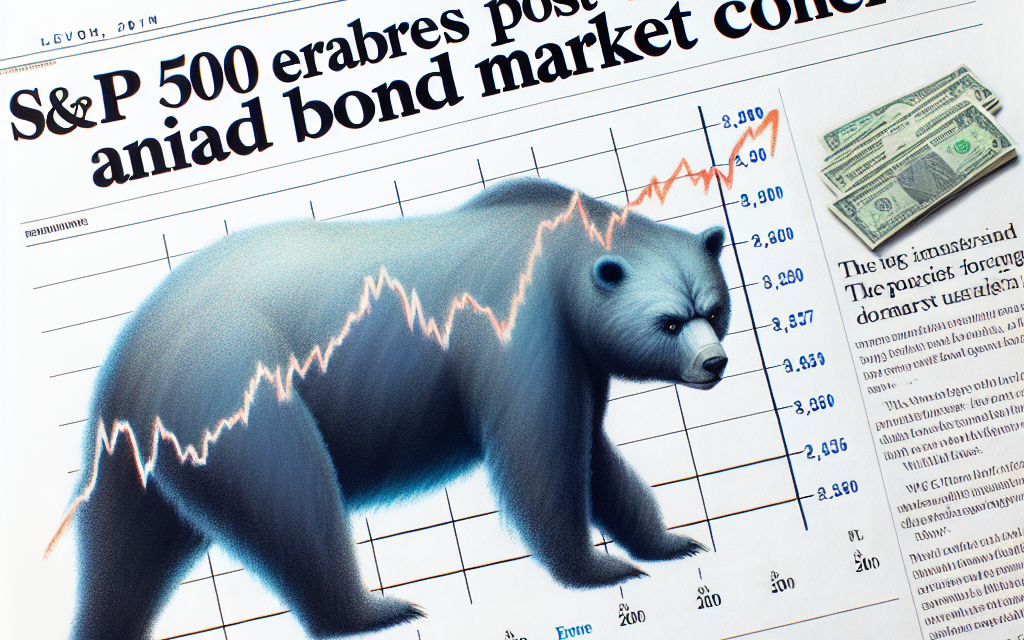“Morning Update: S&P 500 Retreats as Bond Market Woes Weigh on Post-Election Optimism.”
Introduction
The Morning Update highlights the recent performance of the S&P 500, which has seen a significant reversal of its post-election gains. This downturn is largely attributed to growing concerns in the bond market, where rising yields and inflation fears are impacting investor sentiment. As market participants reassess their strategies in light of these developments, the implications for both equities and fixed income are becoming increasingly pronounced.
S&P 500 Performance Post-Election
In the wake of the recent elections, the S&P 500 has experienced a notable shift in its performance, erasing gains that were initially celebrated by investors. Following the election results, which typically generate optimism in the markets, the index surged, reflecting a sense of confidence in the economic policies that might emerge from the newly elected officials. However, this optimism has been tempered by growing concerns in the bond market, leading to a reevaluation of the S&P 500’s trajectory.
As the dust settled post-election, investors began to scrutinize the implications of potential policy changes on interest rates and inflation. The bond market, often viewed as a barometer for economic health, has shown signs of volatility, which has, in turn, influenced equity markets. Rising yields on government bonds have raised alarms among investors, prompting fears that higher borrowing costs could stifle economic growth. Consequently, the S&P 500, which had initially rallied, began to reflect these anxieties, resulting in a downward adjustment.
Moreover, the relationship between bond yields and stock prices is a critical factor in understanding the current market dynamics. Typically, when bond yields rise, the attractiveness of equities diminishes, as fixed-income investments offer more competitive returns. This shift has led to a reassessment of valuations within the S&P 500, particularly among growth stocks that are sensitive to interest rate changes. As investors recalibrate their expectations, sectors that had previously benefited from low interest rates are now facing headwinds, contributing to the index’s decline.
In addition to bond market concerns, geopolitical factors and economic indicators have also played a role in shaping investor sentiment. The uncertainty surrounding international trade policies and potential regulatory changes has added layers of complexity to the market landscape. As a result, the S&P 500’s performance has become increasingly intertwined with broader economic signals, making it essential for investors to remain vigilant and informed.
Furthermore, the earnings season has provided mixed signals, with some companies reporting robust results while others have fallen short of expectations. This divergence has led to increased volatility within the index, as investors weigh the implications of corporate performance against the backdrop of rising interest rates. The interplay between earnings growth and macroeconomic factors is crucial, as it ultimately determines the sustainability of the S&P 500’s recovery.
As we move forward, it is imperative for market participants to closely monitor developments in both the bond market and the broader economic landscape. The S&P 500’s ability to regain its footing will depend on how effectively it navigates these challenges. Investors are likely to remain cautious, seeking clarity on the direction of interest rates and the potential impact on corporate profitability.
In conclusion, the S&P 500’s post-election performance has been marked by a significant reversal of fortunes, driven primarily by concerns in the bond market. As rising yields create headwinds for equities, the index faces a critical juncture. The interplay of economic indicators, corporate earnings, and geopolitical developments will continue to shape investor sentiment and market dynamics. Thus, staying informed and adaptable will be essential for those looking to navigate the complexities of the current investment landscape.
Impact of Bond Market on Stock Indices
In recent weeks, the bond market has exerted a significant influence on stock indices, particularly the S&P 500, which has experienced notable fluctuations in response to changing interest rates and investor sentiment. As the bond market reacts to economic indicators and Federal Reserve policies, stock indices often mirror these movements, reflecting the interconnectedness of these financial sectors. The recent erasure of post-election gains in the S&P 500 serves as a prime example of how bond market dynamics can impact equity performance.
To understand this relationship, it is essential to recognize that bond yields are often viewed as a barometer of economic health. When bond yields rise, it typically signals expectations of higher inflation or stronger economic growth, prompting investors to reassess their portfolios. In this context, rising yields can lead to a shift in capital from equities to fixed-income securities, as investors seek to lock in higher returns. Consequently, the S&P 500 may experience downward pressure as capital flows out of stocks, leading to declines in share prices.
Moreover, the bond market’s reaction to Federal Reserve policy decisions plays a crucial role in shaping investor expectations. For instance, if the Fed signals an intention to raise interest rates to combat inflation, bond yields may spike, prompting a reassessment of risk across the equity markets. This was evident in the recent market movements, where concerns over potential rate hikes led to increased volatility in the S&P 500. Investors, wary of the implications of higher borrowing costs on corporate profits, began to pull back from equities, resulting in a decline in the index.
Additionally, the inverse relationship between bond prices and yields further complicates the landscape for stock investors. As yields rise, bond prices fall, which can create a ripple effect throughout the financial markets. Investors may perceive rising yields as a signal to reduce exposure to riskier assets, such as stocks, in favor of the relative safety of bonds. This shift in sentiment can exacerbate declines in the S&P 500, as seen in the recent market activity.
Furthermore, the impact of global economic conditions cannot be overlooked. International events, such as geopolitical tensions or economic slowdowns in major economies, can influence bond yields and, by extension, stock indices. For instance, if investors anticipate a slowdown in global growth, they may flock to the safety of bonds, driving yields lower and creating a challenging environment for equities. Conversely, if optimism about global recovery takes hold, yields may rise, prompting a reassessment of risk and leading to declines in stock indices like the S&P 500.
In conclusion, the bond market plays a pivotal role in shaping the performance of stock indices, particularly in times of economic uncertainty. The recent decline in the S&P 500, which erased post-election gains, underscores the sensitivity of equities to changes in bond yields and investor sentiment. As the financial landscape continues to evolve, it is crucial for investors to remain vigilant and consider the implications of bond market movements on their equity investments. Understanding this intricate relationship will be essential for navigating the complexities of the current market environment and making informed investment decisions.
Analyzing Market Reactions to Economic Indicators
In the wake of recent economic indicators, the financial markets have exhibited notable volatility, particularly within the S&P 500, which has seen a significant reversal of its post-election gains. This shift can be attributed to a confluence of factors, primarily centered around concerns in the bond market. As investors digest the implications of various economic reports, the reactions observed in equity markets reflect a broader apprehension regarding future monetary policy and its potential impact on growth.
To begin with, the bond market has been under scrutiny as rising yields have prompted a reevaluation of risk assets. The yield on the 10-year Treasury note has surged, signaling a shift in investor sentiment towards inflationary pressures and the Federal Reserve’s potential response. As yields climb, the attractiveness of equities diminishes, particularly for growth stocks that rely on low borrowing costs to fuel expansion. Consequently, this dynamic has led to a sell-off in the S&P 500, as market participants recalibrate their expectations in light of changing economic conditions.
Moreover, recent economic indicators have painted a mixed picture, further complicating the market’s response. For instance, while employment figures have shown resilience, suggesting a robust labor market, other data points, such as consumer spending and manufacturing output, have raised concerns about the sustainability of economic growth. This divergence in economic signals has left investors grappling with uncertainty, prompting a cautious approach to equity investments. As a result, the S&P 500 has experienced fluctuations, reflecting the market’s struggle to reconcile positive employment trends with potential headwinds from inflation and interest rate hikes.
In addition to these economic indicators, geopolitical tensions and global economic developments have also played a role in shaping market sentiment. Investors are increasingly aware of how international events can influence domestic markets, particularly in an interconnected global economy. For instance, supply chain disruptions and trade policies can have far-reaching effects on corporate earnings, which in turn impact stock valuations. As such, the S&P 500’s recent performance can be viewed as a response not only to domestic economic data but also to the broader geopolitical landscape.
Furthermore, the psychological aspect of market behavior cannot be overlooked. Investor sentiment often drives market movements, and the current climate of uncertainty has led to increased volatility. As traders react to news and data releases, the fear of missing out on potential gains or the anxiety of incurring losses can lead to rapid shifts in market positions. This phenomenon has been particularly evident in the S&P 500, where sharp declines have followed periods of optimism, underscoring the fragility of market confidence in the face of economic uncertainty.
In conclusion, the recent performance of the S&P 500, characterized by the erasure of post-election gains, serves as a reflection of the complex interplay between economic indicators, bond market dynamics, and investor sentiment. As the market navigates these challenges, it remains essential for investors to stay informed and adaptable, recognizing that the landscape can shift rapidly in response to new information. Ultimately, the ability to analyze and interpret these economic signals will be crucial for making informed investment decisions in an increasingly volatile environment.
Investor Sentiment and Market Volatility
In recent weeks, investor sentiment has been notably influenced by a confluence of factors, particularly the evolving dynamics within the bond market and the implications of the recent elections. Following the electoral outcomes, the S&P 500 initially experienced a surge, reflecting optimism among investors who anticipated favorable economic policies. However, this optimism has since waned, leading to a significant erasure of those post-election gains. The shift in sentiment can be attributed to growing concerns regarding inflation and interest rates, which have become increasingly pronounced in the bond market.
As investors grapple with these concerns, market volatility has surged, creating an environment of uncertainty. The bond market, often viewed as a barometer for economic health, has exhibited fluctuations that have sent ripples through equity markets. Rising yields on government bonds have raised alarms about potential increases in borrowing costs, which could stifle economic growth. Consequently, this has led to a reassessment of risk among investors, prompting many to adopt a more cautious stance. The interplay between bond yields and stock prices has historically been complex, and the current environment is no exception. As yields rise, the attractiveness of equities diminishes, particularly for growth stocks that rely heavily on future earnings.
Moreover, the Federal Reserve’s monetary policy decisions play a crucial role in shaping investor sentiment. As the central bank navigates the delicate balance between curbing inflation and supporting economic growth, its actions are closely scrutinized by market participants. Recent statements from Fed officials have hinted at a more hawkish stance, which has further exacerbated concerns about rising interest rates. This has led to increased volatility in the markets, as investors attempt to gauge the timing and magnitude of potential rate hikes. The uncertainty surrounding monetary policy has created a challenging environment for investors, who must now weigh the risks of holding equities against the backdrop of a potentially tightening monetary landscape.
In addition to these macroeconomic factors, geopolitical tensions and global economic conditions have also contributed to the prevailing market volatility. Investors are increasingly aware of how international events can impact domestic markets, leading to a heightened sense of caution. The interconnectedness of global economies means that developments in one region can have far-reaching implications elsewhere. As such, investors are not only focused on domestic indicators but are also keeping a close eye on international developments that could influence market dynamics.
As the S&P 500 continues to navigate this turbulent landscape, it is essential for investors to remain vigilant and adaptable. The current environment underscores the importance of a diversified investment strategy that can withstand fluctuations in both equity and bond markets. By maintaining a balanced portfolio, investors can better position themselves to weather the storms of market volatility while capitalizing on potential opportunities that may arise.
In conclusion, the recent erasure of post-election gains in the S&P 500 serves as a reminder of the intricate relationship between investor sentiment, market volatility, and macroeconomic factors. As concerns about the bond market and interest rates persist, investors must remain informed and agile in their decision-making processes. The evolving landscape presents both challenges and opportunities, and those who can navigate it effectively will be better equipped to achieve their financial objectives in an increasingly complex market environment.
Historical Context of Post-Election Market Trends
The relationship between U.S. elections and market performance has long been a subject of interest for investors and analysts alike. Historically, the stock market tends to react to the outcomes of elections, often reflecting the prevailing sentiment regarding economic policies and governance. In the aftermath of elections, particularly presidential ones, the S&P 500 has frequently experienced fluctuations that can be attributed to investor sentiment, policy expectations, and broader economic indicators. For instance, following the 2016 election, the S&P 500 surged as investors anticipated pro-business policies under the new administration. This trend was not isolated; similar patterns have been observed in previous election cycles, where the market often rallies in the immediate aftermath of a decisive electoral outcome.
However, the post-election euphoria is not always sustained. As the initial excitement fades, market participants begin to reassess the implications of the election results, leading to a more measured response. This phenomenon can be attributed to various factors, including the realization of the complexities involved in implementing campaign promises and the potential for political gridlock. For example, after the 2008 election, the S&P 500 initially rose, buoyed by hopes for economic recovery and reform. Yet, as the realities of the financial crisis set in, the index faced significant challenges, ultimately leading to a prolonged period of volatility.
In recent years, the bond market has also played a crucial role in shaping investor sentiment and market dynamics. The relationship between equities and bonds is often inversely correlated; when bond yields rise, equities may face downward pressure as investors reassess risk and return profiles. This interplay becomes particularly pronounced in the context of post-election scenarios, where shifts in fiscal policy and interest rates can significantly impact market expectations. For instance, if a newly elected administration signals intentions to increase government spending, concerns about inflation may lead to rising bond yields, which in turn can dampen enthusiasm for equities.
The current landscape reflects these historical trends, as the S&P 500 has recently erased its post-election gains amid growing concerns in the bond market. Investors are grappling with the implications of potential interest rate hikes and inflationary pressures, which have led to a reevaluation of risk across asset classes. This situation underscores the importance of monitoring economic indicators and policy developments, as they can have profound effects on market trajectories. Moreover, the interplay between fiscal policy and monetary policy remains a critical consideration for investors navigating the complexities of the post-election environment.
As we look to the future, it is essential to recognize that while historical patterns provide valuable insights, each election cycle presents unique challenges and opportunities. The current market dynamics serve as a reminder of the intricate relationship between political events and economic outcomes. Investors must remain vigilant, adapting their strategies to the evolving landscape shaped by both domestic and global factors. Ultimately, understanding the historical context of post-election market trends can equip investors with the knowledge needed to navigate the uncertainties that lie ahead, fostering a more informed approach to decision-making in an ever-changing financial environment.
Strategies for Navigating Market Uncertainty
In the wake of recent market fluctuations, particularly following the S&P 500’s erasure of post-election gains, investors are increasingly seeking effective strategies to navigate the prevailing uncertainty. The bond market’s volatility has raised concerns, prompting a reevaluation of investment approaches. As economic indicators fluctuate and geopolitical tensions persist, it becomes imperative for investors to adopt a proactive stance in managing their portfolios.
One of the foremost strategies to consider is diversification. By spreading investments across various asset classes, sectors, and geographic regions, investors can mitigate risks associated with market downturns. This approach not only helps in cushioning against losses but also positions portfolios to capitalize on potential gains in different areas. For instance, while equities may be under pressure, fixed-income securities or commodities could provide a buffer, thereby enhancing overall portfolio resilience.
In addition to diversification, maintaining a long-term perspective is crucial during periods of market volatility. Short-term fluctuations can often lead to emotional decision-making, which may result in suboptimal investment choices. By focusing on long-term goals and adhering to a well-defined investment strategy, investors can avoid the pitfalls of panic selling. This disciplined approach allows for the potential recovery of investments as markets stabilize over time.
Moreover, it is essential to stay informed about macroeconomic trends and market dynamics. Understanding the factors driving market movements, such as interest rate changes, inflationary pressures, and fiscal policies, can empower investors to make informed decisions. For instance, if bond yields are rising due to anticipated interest rate hikes, investors may want to reassess their exposure to interest-sensitive assets. By keeping abreast of economic developments, investors can better position themselves to respond to changing market conditions.
Another effective strategy is to consider the use of hedging techniques. Options and futures can serve as valuable tools for managing risk, allowing investors to protect their portfolios against adverse price movements. For example, purchasing put options on equity indices can provide a safety net during market downturns, thereby limiting potential losses. While hedging may involve additional costs, it can be a prudent measure in uncertain environments, particularly for those with significant exposure to volatile assets.
Furthermore, investors should not overlook the importance of liquidity. In times of market stress, having access to cash or liquid assets can provide flexibility and enable opportunistic investments. By maintaining a portion of their portfolio in cash or cash-equivalents, investors can take advantage of attractive buying opportunities that may arise during market corrections. This strategy not only enhances financial stability but also positions investors to act swiftly when favorable conditions present themselves.
Lastly, seeking professional advice can be invaluable in navigating complex market landscapes. Financial advisors can offer tailored insights and strategies based on individual risk tolerance and investment objectives. Their expertise can help investors make informed decisions, particularly in times of heightened uncertainty. By collaborating with professionals, investors can gain a clearer understanding of their options and develop a comprehensive plan that aligns with their long-term financial goals.
In conclusion, while the current market environment presents challenges, employing a combination of diversification, long-term focus, informed decision-making, hedging strategies, liquidity management, and professional guidance can significantly enhance an investor’s ability to navigate uncertainty. By adopting these strategies, investors can better position themselves to weather market fluctuations and seize opportunities as they arise.
Future Outlook for the S&P 500 Amid Economic Concerns
As the S&P 500 grapples with the implications of recent economic developments, investors are increasingly focused on the future outlook for this key index. Following the recent elections, the S&P 500 initially experienced a surge, reflecting optimism about potential policy changes and economic recovery. However, this momentum has since dissipated, primarily due to rising concerns in the bond market. The bond market’s fluctuations often serve as a barometer for investor sentiment, and the current environment suggests a cautious approach moving forward.
One of the primary factors influencing the S&P 500’s trajectory is the ongoing uncertainty surrounding inflation and interest rates. As inflationary pressures persist, the Federal Reserve’s response becomes critical. Investors are keenly aware that any signals of tightening monetary policy could lead to increased borrowing costs, which in turn may dampen corporate earnings. Consequently, the S&P 500, which is heavily influenced by the performance of large-cap companies, may face headwinds if economic growth slows as a result of higher interest rates.
Moreover, the bond market’s recent volatility has raised questions about the sustainability of the current economic recovery. With yields on government bonds rising, there is a growing concern that investors may shift their focus away from equities in favor of fixed-income securities that offer more attractive returns. This shift could lead to a reallocation of capital, further pressuring the S&P 500 as investors seek safer havens amid economic uncertainty. As a result, market participants are closely monitoring bond yields, as any significant increases could trigger a broader sell-off in equities.
In addition to interest rate concerns, geopolitical tensions and supply chain disruptions continue to pose risks to the economic landscape. The ongoing conflict in various regions and the lingering effects of the pandemic have created an environment of unpredictability. These factors not only impact consumer confidence but also affect corporate profitability, which is a critical driver of stock prices. As companies navigate these challenges, the S&P 500 may experience increased volatility, reflecting the broader economic sentiment.
Furthermore, earnings reports from major corporations will play a pivotal role in shaping the outlook for the S&P 500. As companies disclose their financial performance, investors will be keen to assess whether earnings growth can keep pace with inflation and rising costs. If earnings disappoint, it could lead to a reassessment of valuations across the index, potentially resulting in downward pressure on stock prices. Conversely, strong earnings could provide a much-needed boost to investor confidence, helping to stabilize the index amid external pressures.
In light of these considerations, the future outlook for the S&P 500 remains uncertain. While there are opportunities for growth, particularly in sectors poised to benefit from technological advancements and changing consumer behaviors, the overarching economic concerns cannot be overlooked. Investors must remain vigilant, balancing their portfolios to navigate the complexities of the current market environment. As the S&P 500 continues to respond to both domestic and global developments, a cautious yet strategic approach will be essential for those looking to capitalize on potential opportunities while mitigating risks. Ultimately, the interplay between economic indicators, corporate performance, and investor sentiment will dictate the index’s path in the months ahead.
Q&A
1. **What recent event caused the S&P 500 to erase its post-election gains?**
Concerns in the bond market.
2. **What was the primary factor influencing the bond market’s performance?**
Rising interest rates and inflation fears.
3. **How did the S&P 500 perform following the election?**
It initially gained but later erased those gains.
4. **What impact do bond market concerns have on the stock market?**
They can lead to increased volatility and reduced investor confidence.
5. **What economic indicators are investors watching closely?**
Inflation rates and Federal Reserve interest rate decisions.
6. **What sectors of the S&P 500 were most affected by these developments?**
Interest-sensitive sectors like utilities and real estate.
7. **What is the outlook for the S&P 500 amid these bond market concerns?**
Uncertainty remains, with potential for further volatility depending on economic data.
Conclusion
The Morning Update highlights that the S&P 500 has reversed its post-election gains due to rising concerns in the bond market, indicating investor anxiety over interest rates and economic stability. This shift reflects a broader apprehension about the potential impact of monetary policy on market performance, suggesting a cautious outlook for equities in the near term.





